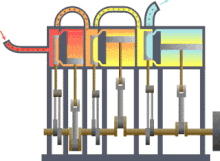External combustion engine is an engine almost similar to internal combustion engine. The only difference is the ignition of the fuel occurs external to the engine. Ignited fuel come into the combustion chamber on the both sides alternately, so that they push both sides of the piston up and down.
Some examples of the external combustion engines are the steam engines. Water is heated in the boiler, that uses a fuel (wood). This heated water will be steam and will push the piston up and down.
Industrial Revolution

Industrial Revolution during 1760 - 1820, got its strength from steam engines. It was used in railways, for transporting goods. Many automobiles were built using these type of engines. The European Industrial Revolution transported mined metals and raw materials using railways, that used steam engines, an external combustion engine. Modern steam engine was invented by James Watt, who used many scientific properties to build a steam engine, called Watt Steam Engine.
Mechanism

It is a simple mechanism. To push the piston up and down, pressure is needed. Here, one stroke can be possible as a single piston goes up and down on its own(in internal combustion engine, one piston goes down, and the other up) producing a 360 degree rotation. For this, a sliding valve, that can slide up and down is used. The steam will go in the upper direction, if the sliding valve goes down and blocks the way down. The steam goes in the downward direction, if the valve goes up and blocks the way up. When the valve is down, the piston moves down, and the steam will go inside a pipe in the valve. This pipe will direct the steam to the next combustion chamber, and then the next. The final steam will go to a condenser, when it will again become water, then to the boiler where it will become steam.
An animation from Wikipedia shows the movement of steam engine
Sliding Valve
Sliding valve is a special valve that goes up and down, directing the steam down and up respectively. This is done to get the piston moving up and down to get rotatory motion.
Boiler
Boiler is a special compartment, where a fuel (wood) is burnt to heat water to steam. This steam will then pass on to the combustion chamber, where it is used to push the piston up ans down. Water must also be passed to boiler at a fixed amount because we would now want the whole amount of water to convert into steam and causing the boiler to explode. So a special device called Injector, is used to get water at fixed rate into the Boiler.
Injector
An injector is a special machinery used to inject a low pressure substance, to a high pressurized, so that it just shoots out where we want. It is used in steam engines as it gives water high pressurized and periodically so that equal amount of water gets to boil. It has two entry tubes. One for the steam and one for water. These two meet at the middle path, where the steam becomes water and the whole water becomes a little heated. This will pass through a middle path, where the path is thin, to get high pressures. This high pressurized water goes into the boiler, periodically and we get equal amounts of water to boil. It works on a principle, called Venturi Effect that explains that pressure is inversely proportional to the cross sectional area. It means that pressure increases when the cross sectional area decreases. That's why, injectors have a thin path in the middle, so that the water becomes pressurized.
_________________________________________________________________________________
See the following video from You tube, how an injector works:
Article by M. Santosh
_________________________________________________________________________________




No comments:
Post a Comment